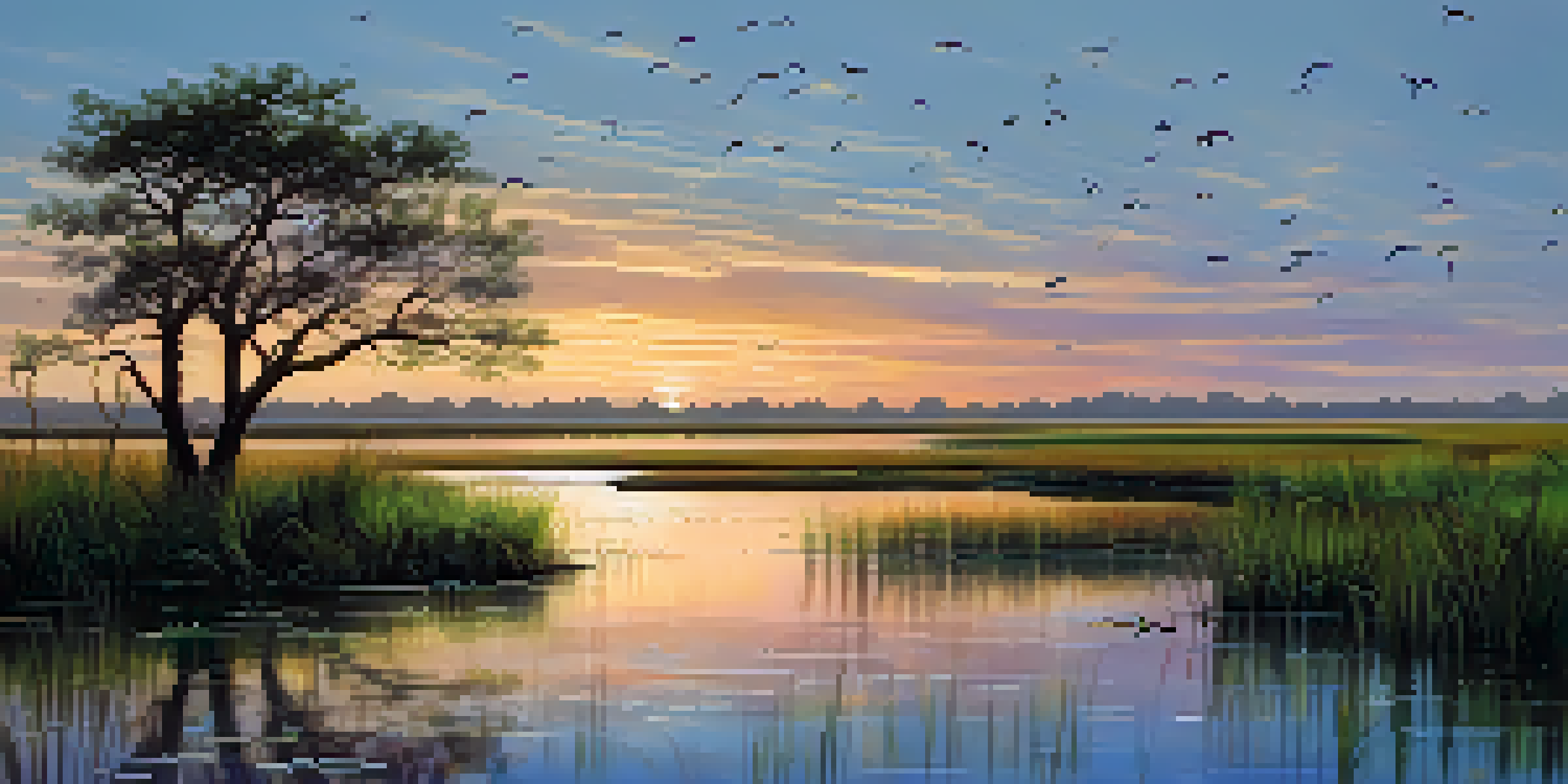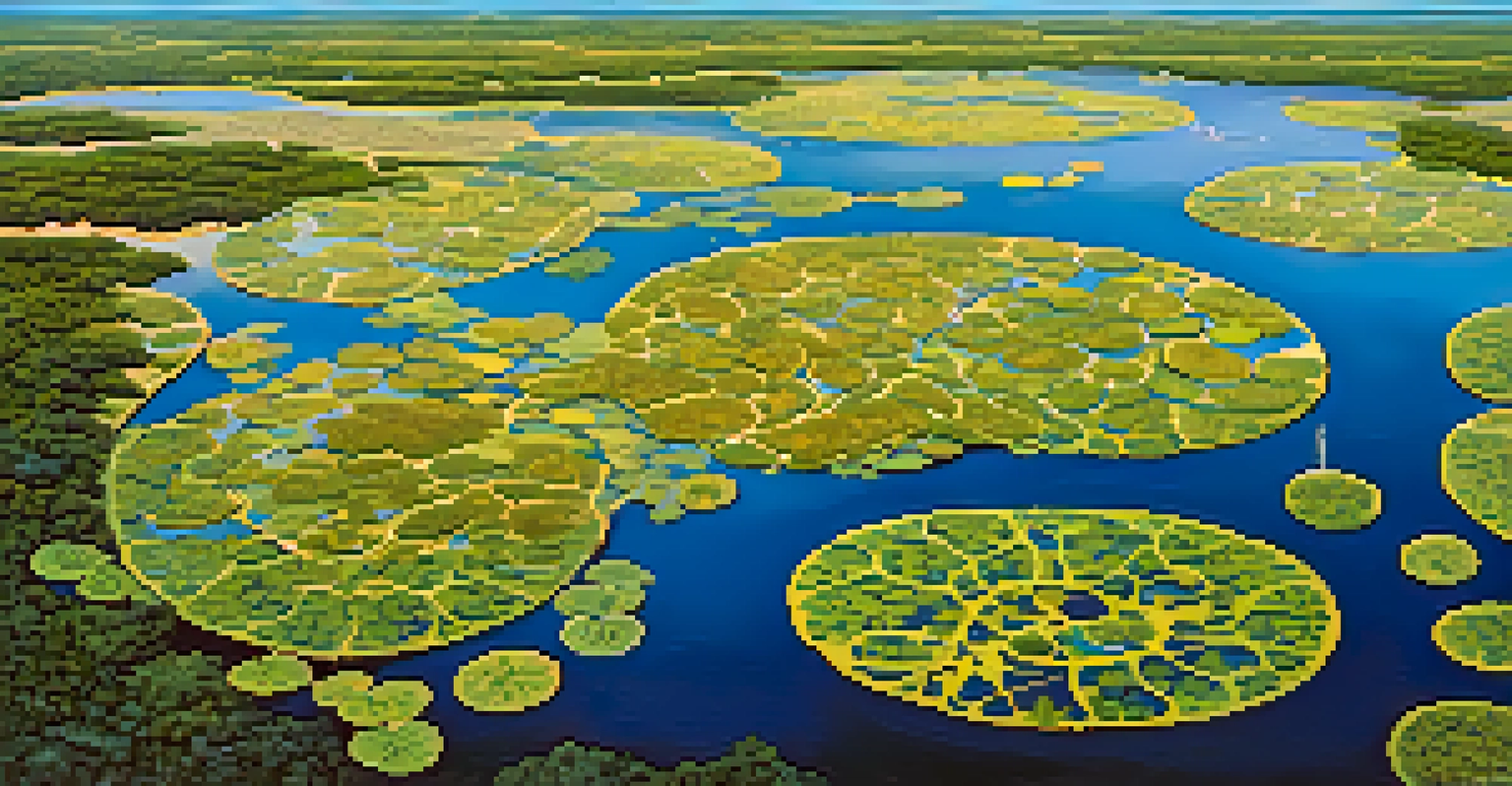The Importance of Texas Wetlands for Wildlife Preservation

Understanding Texas Wetlands and Their Ecosystem Role
Texas wetlands are unique ecosystems that include marshes, swamps, and estuaries. These areas act as natural sponges, absorbing excess water during heavy rains and slowly releasing it during dry spells. This balance helps prevent flooding and maintains water quality, making wetlands crucial for both wildlife and human communities.
Wetlands are among the most productive ecosystems in the world, providing a wide range of ecological services that benefit both human and wildlife populations.
The biodiversity found in Texas wetlands is astonishing. They provide habitats for various species, including migratory birds, amphibians, and fish. For example, the coastal wetlands of Texas serve as essential stopover points for thousands of migrating birds, offering food and shelter during their long journeys.
Furthermore, wetlands play a vital role in nutrient cycling. They filter pollutants and improve water quality, ensuring that the wildlife depending on these habitats thrives. This ecological function highlights why preserving wetlands is not just beneficial for wildlife but essential for the overall health of the environment.
The Role of Wetlands in Wildlife Habitat
Wetlands are often called nurseries for wildlife because they provide critical breeding and feeding grounds. Fish and amphibians lay eggs in the shallow waters, ensuring that their young have shelter from predators. This protective environment fosters healthy populations of many species, contributing to biodiversity.

In addition to aquatic life, wetlands support a variety of terrestrial species. Mammals such as beavers, otters, and even deer rely on these ecosystems for food and shelter. The complex food web within wetlands showcases how interconnected these environments are, as each species plays a role in maintaining the ecosystem's balance.
Wetlands: Vital Ecosystem Services
Texas wetlands play a crucial role in flood prevention, water quality improvement, and providing habitats for diverse wildlife.
Moreover, the presence of wetlands can enhance surrounding habitats. They offer a buffer against extreme weather and serve as migration corridors for terrestrial wildlife. This interconnectedness underscores the importance of conserving wetlands to support wildlife beyond their boundaries.
Wetlands as Natural Water Filters
One of the most significant functions of Texas wetlands is their ability to filter pollutants from water. The plants and microorganisms within these ecosystems break down harmful substances, improving water quality for both wildlife and humans. This natural filtration process is crucial for maintaining the ecological integrity of rivers and lakes downstream.
The future will be shaped by the choices we make today. Protecting wetlands is about ensuring a sustainable environment for future generations.
For instance, when stormwater runs off urban areas, it often carries pollutants that can harm aquatic life. Wetlands help mitigate this impact by trapping sediments and absorbing nutrients before they reach larger bodies of water. This not only protects wildlife but also enhances the recreational value of Texas waterways.
The economic benefits of clean water are substantial, as many communities rely on these resources for fishing, boating, and tourism. By preserving wetlands, we invest in the health of our ecosystems and the prosperity of our local economies, highlighting the interdependence between nature and human livelihoods.
The Impact of Climate Change on Texas Wetlands
Climate change poses a significant threat to Texas wetlands, leading to shifts in hydrology and habitat loss. Rising temperatures can cause increased evaporation, reducing water levels in these critical areas. This change not only impacts the plants and animals that depend on wetlands but also affects the services they provide to humans.
Additionally, extreme weather events, such as hurricanes and droughts, can devastate wetland ecosystems. These events can lead to erosion and sedimentation, disrupting the delicate balance that supports wildlife. As we witness these changes, it's vital to understand the long-term implications for biodiversity and ecosystem health.
Economic Benefits of Wetland Preservation
Preserving wetlands contributes to local economies through tourism, fishing, and reduced flood management costs.
To combat these challenges, conservation efforts must be prioritized. Implementing sustainable management practices and restoring damaged wetlands can help mitigate the impacts of climate change. By taking action now, we can protect these vital ecosystems for future generations and ensure that wildlife continues to thrive in Texas.
The Economic Value of Wetland Preservation
Preserving Texas wetlands is not just an environmental issue; it's an economic one as well. Healthy wetlands provide essential services that contribute to local economies, from tourism to fishing industries. The natural beauty and recreational opportunities offered by wetlands draw visitors, generating revenue for surrounding communities.
Moreover, wetlands can help reduce the cost of flood management. By absorbing excess rainwater, they minimize damage to infrastructure and property during storms. This cost-saving aspect emphasizes the importance of investing in wetland conservation as a proactive measure against future disasters.
In addition to direct economic benefits, wetlands support sustainable agriculture by improving water quality and soil health. Farmers can benefit from the natural filtration and nutrient cycling that wetlands provide, leading to healthier crops and reduced reliance on chemical fertilizers. This interconnectedness between wetlands and agriculture highlights how preserving these ecosystems is beneficial for all.
Community Engagement in Wetland Conservation
Community involvement is crucial for the successful preservation of Texas wetlands. Local residents play a pivotal role in advocating for conservation efforts and participating in restoration projects. By fostering a sense of ownership and responsibility, communities can help ensure that these ecosystems are protected for future generations.
Educational programs and outreach initiatives can empower citizens to understand the importance of wetlands. By raising awareness about the ecological and economic benefits, communities can mobilize support for conservation policies and funding. Engaging local schools and organizations in hands-on activities can also inspire the next generation to become stewards of these vital ecosystems.
Community's Role in Conservation
Engaging local communities in wetland conservation efforts is essential for ensuring these ecosystems are protected for future generations.
Furthermore, collaboration between government agencies, nonprofits, and community members can enhance conservation efforts. By working together, stakeholders can share resources, knowledge, and strategies, leading to more effective protection of wetlands. This collective approach not only strengthens conservation initiatives but also builds a sense of community around shared values.
Conclusion: The Future of Texas Wetlands
The future of Texas wetlands hinges on our collective action and commitment to conservation. As we face an array of environmental challenges, safeguarding these ecosystems should be a top priority. The benefits they provide to wildlife and humans alike are invaluable, making their preservation essential for a healthy, sustainable future.
By raising awareness, supporting local conservation initiatives, and advocating for policies that protect wetlands, we can create a positive impact. Every effort counts, whether it’s participating in a local clean-up or contacting lawmakers about environmental protection. Together, we can ensure that Texas wetlands continue to thrive.

Ultimately, the preservation of Texas wetlands is not just about protecting a habitat; it’s about securing a future where wildlife and communities coexist harmoniously. Let’s work together to cherish and protect these vital ecosystems, ensuring they remain vibrant and resilient for generations to come.